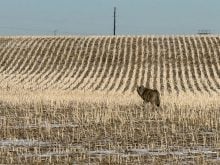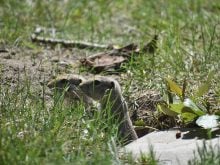Fire. Our prairie immigrant ancestors feared it. Subsequent generations farmed with it and now some of our native prairie needs it.
“Once every 10 years is often enough. But well-managed fire is a necessary part of maintaining our native prairie … it can be an important tool for dealing with unwanted (domestic) plants and weeds,” said Bohdan Pylypec, a technician with the University of Saskatchewan.
Before European settlers began tilling the West, fire cleansed the land of dead plant material. The process limited the growth of any one plant. Bison also played an important role in controlling plant growth by grazing.
Read Also

Agritechnica Day 2: The future of tractor power, building quicker crop apps and large farms and tech
Agritechnica Day 2: The future of tractor power, building quicker crop apps with Syngenta and large farms and tech
The fires, unlike the popular myth, were generally small and patchy events, often started by humans to control bison migration and took place most frequently in October and between March and May.
Native plants adapted to the burning and protected themselves against it by developing reproductive structures tolerant to the flames, allowing them to take advantage of open areas after the fire, especially the blazes of early spring.
“Early spring is still the best time for landowners to consider a controlled burn,” said Jennifer Neudorf, a University of Saskatchewan graduate student working in the field.
She said research has shown marked improvements in recovery, after a spring burn over prairie that was scorched late in the year. The burning also allows vegetation to build up and act as snow trap in winter.
One of the greatest threats to the remaining six million acres of Saskatchewan’s native prairie, the remains of more than 40 million acres of 125 years ago, is the encroachment of the dryland grasses such as brome grass.
The plant was developed in the first half of this century and has remained a strong competitor to native species.
“It has been used for years for roadside ditches and pastures. From the roadsides it has spread into the native prairie. There it is hard to control… . Fire and selective application of herbicides can help control the spread,” said Leslie Hall, co-ordinator of the Native Prairie Stewardship Program.
For small patches of brome grass a combination of cultivation, fire and herbicide application are most effective.
“Fire alone is loved by brome grass. In combination with other techniques though it will get rid of the problem,” said Neudorf.
“Wick (wiper) type herbicide applicators will work well because the (brome) grass stands above most of the native plants. You want to hit it about the middle of June when the plant is placing all of its resources into a new growth stage,” said Neudorf.
Methods of control
Fire can be used to control trees and brush like aspen and wolf willow. When combined with intense grazing, non-selective herbicide and bark scraping, small trees and brush can be controlled, say rangeland specialists.
“Landowners can also reduce the risk of an uncontrolled fire by burning off the extra material that has built up,” said Pylypec.
He said for the best results in clearing wolf willow and small aspen stands, a hot burn is necessary. Back burning, or burning against the wind will provide the extra heat needed to kill the heavier plants. Fire guards are necessary, he added.
“Just do a patch here and a patch there. It will allow the remaining prairie plants to populate the newly burned area,” said Neudorf.














